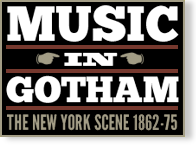Hampton Institute Students Concert
Event Information
Venue(s):
Steinway Hall
Price: $.50; $.25 extra for reserved seat
Performance Forces:
Vocal
Record Information
Status:
Published
Last Updated:
16 November 2024
Performance Date(s) and Time(s)
11 Mar 1873, EveningPerformers and/or Works Performed
Citations
“A concert was given last evening at Steinway Hall by some of the students at the Hampton Academy, and for the benefit of that worthy institution. If the black race is to be educated it must be by means of such schools as this.
The concert was of much the same character as those given here last winter by a number of the pupils of the Fisk University, also an institute for colored students. This class of concert is interesting mainly from the association that the music has with the history of an enslaved race.
These songs stand in the same relation to musical art that the people from whom they spring do to the intelligence and culture of the century. Both are on the lowest plane. But in the plaintive strains are pictured the condition of the race. The music is rude and barbarous; it is written in rude scales and with dissonant intervals that could nowhere else be tolerated. It is not lit up by a particle of joy, but is the vehicle through which an enslaved and ignorant people gathered together in their cabins at night to give expression to their hopes and to their religious feelings. The words are equally rude, and deal with matters of awful solemnity with an easy familiarity that if it were enlightened would be blasphemous.
Nor is the singing much better than the music. The voices are coarse and constantly out of tune, though the singers, of whom there are seventeen, were usually very prompt and correct in the matter of time. This shows that the musical instinct is there but that it lacks development and cultivation. But these seeming drawbacks contribute really to the interest of the performances. The moment the music becomes finished and artistic, that moment all its real merit will be gone. The weakest pieces upon the programme were those that in point of musical composition were best, for here the performers were clearly out of their element.
Several other concerts will be given here by these students, and apart from the interest that attaches to their peculiar melodies the object in aid of which the concerts are given is one that should commend itself to every one having sympathy with the colored race.”
“Parepa-Rosa or Nilsson would have been cheered at the sight of the audience assembled at Steinway Hall last night. And yet it was but a colored concert—not of the rose-tinted character which the above mentioned artists were accustomed to, but dusky in its elements. A white audience sat and applauded the efforts of nineteen dark-skinned vocalists, who made up for a want of artistic training by a deal of earnestness, commendable energy and an intimate knowledge of the selected themes. Even the much vaunted Handel and Haydn Society would have failed to convey the occult sentiment of choruses like ‘Run, Mary Run’ and ‘Sweet Canaan,’ and the baton of Carl Zerrahn would have been powerless in the ‘Dat great gittin’ up mornin’.’ It requires a dusky Rudersdorff to ‘See de moon a bleedin’,’ and an ebony Santley to ‘See de dry bones a creepin’.’ However strange such strains may sound to regular concert-goers, the Hampton students sing them well and even create enthusiasm. It is not always mere correctness or artistic mechanism that stirs an audience. Earnestness, combined with fire, can do a great deal. We have a notable instance of it on the operatic stage.”

